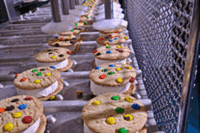Though I’ve been editing magazines for many years, the arrival of a new issue still excites me. It’s like receiving a birthday or Christmas present every month. Each issue ofDairy Foodsis packed with information you can act on. Here is a sample of what we’ve delivered in the last 12 months.
Though I’ve been editing magazines for many years, the arrival of a new issue still excites me. It’s like receiving a birthday or Christmas present every month. Each issue of Dairy Foods is packed with information you can act on. Here is a sample of what we’ve delivered in the last 12 months.
Combine nuts into dairy. Roth Käse USA sells a package of three single servings of blue, Gruyere and Gouda cheese, crackers and a dried fruit and nut mix. Austria’s Rombol markets a walnut cream cheese torte, and Group Danone tested a limited-edition cashew variety of Activia yogurt in Brazil. (“Nutty Ways to Innovate,” January)
Be a global player. “You have to be competitive with the world market. We have more to learn as global players, but you either do that or take the route of the U.S. auto industry,” says Richard Cotta of California Dairies. The dairy’s new dryer and evaporator were designed to meet world specifications. (“World of Opportunities,” January)
See the bottom line everywhere. Are you aware of the concept of “cost per unit sweetness?” That is a value that represents the contribution of a given ingredient to the perceived sweetness of sucrose, which is arbitrarily given a sweetness of one. (“Blending Sweeteners Can Improve Product and Bottom Line,” February)
Be smart about product launches. “Price alone is not a reason to launch a product,” says David Reische of H.E. Butt Grocery Co. “We don’t launch a product under the HEB brand that doesn’t consumer-test at least as well as the national brand. If it’s going to be ‘me better,’ it’s going to provide a functional, nutritional or packaging benefit that doesn’t already exist.” (“Aiming High,” February)
Demonstrate your products. Sartori Foods is building a culinary kitchen at its corporate headquarters. (“Calling in the Reserve,” March)
Niche your products. Chobani makes Greek yogurts for children’s tastes and packages them in 4-ounce cups to accommodate child-size appetites. (“Cultured Dairy Delights Consumers,” April)
Good Cow Co. sells aseptic and fresh milk to regional coffee shops. “Our products were specifically developed for cafes to be a more efficient and environmentally conscientious way to purchase milk than traditional retail packages,” says Trish Corby, president and CEO. (“Coffee in Your Milk,” March)
Think hybrids. Frozen yogurt is a merger of “two distinct types of processed dairy foods – yogurt and frozen dessert,” write columnists Bruce Tharp and Steven Young. They propose using sour cream and cultured buttermilk in frozen desserts. (“Hybrids Offer novel Product concepts,” April)
Tell the story of your ingredients. Jim May, founder of Wisdom Natural Brands, writes on his Facebook page how he met with stevia farmers in South America. Consumers like these back stories. (“The Future of Food is Now,” May 2010)
Find new markets. Wells’ Dairy developed 4-ounce servings of Blue Bunny Nutriplus for hospitals and nursing homes. A serving contains 9 grams of protein and 2 grams of fiber. (“Check This Out!,” September)
Packaging counts. Upstate Niagara Cooperative developed a shelf-stable flavored milk called Crave, sold in aluminum cans. (“New Product Review,” October)
Milfroma markets a shake-type drink called Shakeria, which is packaged in a spill-proof, reclosable single-serve container with telescopic drinking straw. (“Shaking up the Paris Show,” November)
This issue contains more actionable information, which you can discover on your own.
Here’s wishing you a healthy, safe and prosperous holiday.
Get our new eMagazine delivered to your inbox every month.
Stay in the know on the latest dairy industry trends.
SUBSCRIBE TODAYCopyright ©2024. All Rights Reserved BNP Media.
Design, CMS, Hosting & Web Development :: ePublishing



